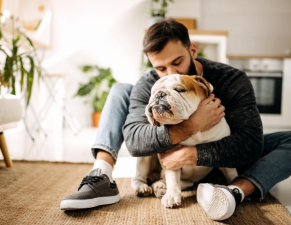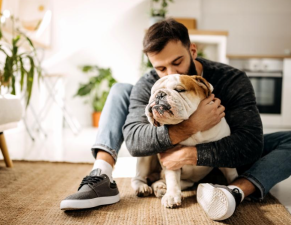
More and more people are keeping pets. Pets are part of the family, and they occupy a special place in the home.
Therefore, when designing a pet-friendly home, designers must not only consider the human experience and functionality of space, but also the pet's physiological habits.
"Choosing Wall and Floor Materials"
Choosing Floor Materials
- The floor is where pets frequently come into contact. Cats and dogs alike have sharp claws. Solid wood flooring is too soft and easily scratched by claws, so it's recommended to avoid it to prevent pets from scratching it. It's best to replace the floor with easy-to-clean, non-bubbling tiles, such as ceramic tile. Choose a surface with a three-dimensional, embossed pattern to improve grip and prevent slips and falls when pets run. For pet safety, avoid sharp corners.
- For homes with yards, it's best not to use gravel to pave the ground, as it can be carried inside. Cedar and other wood materials should also be avoided. In general, carpets are placed beneath the sofa and coffee table in the living room. However, for families with pets, carpeting is a breeding ground for bacteria and pet hair, so avoid carpeting if possible.
- Choosing Wall Materials: Both cats and dogs love to rub their bodies against walls or scratch their claws. Over time, this can cause the walls to become dark and dirty, and also leave scratch marks. Avoid wallpaper to prevent scratches, and opt for washable paint instead.

Dividing Pet Functional Spaces
For families with pets, it's important to plan the functional needs of both the owner and the pet accordingly.
On the one hand, consider the user experience, while on the other, consider the movement paths of both people and pets within the space. These two routes should be independent and not interfere with each other. Pet movement paths are often located on the ceiling or walls.
Pet Resting Area: Pets, like their children, are dependent on their owners. Therefore, a pet resting area is best located in the owner's bedroom, but can also be set up in the living room, against a wall. Resting and sleeping areas should be tailored to the pet's breed, personality, and age. For dogs with protective abilities and awareness, consider placing a rest area near the entrance. This can play a protective role, giving pets a sense of accomplishment and psychological well-being.
Furniture Selection
Because both owners and playful pets are part of the family, practicality and aesthetics are paramount in our design. Pets can grind their teeth and use their claws to climb. Therefore, we avoid fragile, non-repairable materials like leather and plush, opting instead for removable, easy-to-clean, and durable materials. Furniture surfaces should be as smooth and dense as possible to harbor bacteria. Colors should be simple and elegant to avoid the obvious presence of messy pet hair. This can better integrate the functional needs of both humans and cats, allowing owners and pets to coexist harmoniously and maintain their own space.
Storage cabinets must have doors to keep items enclosed. This prevents pets from damaging clothing, books, and the owner's mind. If there is sufficient space around the cabinet, stepped partitions can be installed towards the top. This provides a separate space for the cat and effectively prevents damage. Kitchen Style: The kitchen style is determined by the owner's preferences. If the owner prioritizes a cohabiting experience with their pet and fostering a positive relationship, an open kitchen is a good choice. If the owner cannot handle unexpected situations caused by their pet while cooking, an enclosed kitchen is the best option.
